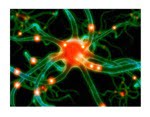Dopamine inhibits some stop circuits as it strengthen go circuits

Unlocking mystery of why dopamine freezes Parkinson’s patients
CHICAGO — Parkinson’s disease and drug addiction are polar opposite diseases, but both depend upon dopamine in the brain. Parkinson’s patients don’t have enough of it; drug addicts get too much of it. Although the importance of dopamine in these disorders has been well known, the way it works has been a mystery.
New research from Northwestern University’s Feinberg School of Medicine has revealed that dopamine strengthens and weakens the two primary circuits in the brain that control our behavior. This provides new insight into why a flood of dopamine can lead to compulsive, addictive behavior and too little dopamaine can leave Parkinson’s patients frozen and unable to move.
“The study shows how dopamine shapes the two main circuits of the brain that control how we choose to act and what happens in these disease states, ” said D. James Surmeier, lead author and the Nathan Smith Davis Professor and chair of physiology at the Feinberg School. The paper is published in the August 8 issue of the journal Science.
These two main brain circuits help us decide whether to act out a desire or not. For example, do you get off the couch and drive to the store for an icy six-pack of beer on a hot summer night, or just lay on the couch?
One circuit is a “stop” circuit that prevents you from acting on a desire; the other is a “go” circuit that provokes you to action. These circuits are located in the striatum, the region of the brain that translates thoughts into actions.
In the study, researchers examined the strength of synapses connecting the cerebral cortex, the region of the brain involved in perceptions, feelings and thought, to the striatum, home of the stop and go circuits that select or prevent action.
Scientists electrically activated the cortical fibers to simulate movement commands and boosted the natural level of dopamine. What happened next surprised them. The cortical synapses connecting to the “go” circuit became stronger and more powerful. At the same time, dopamine weakened the cortical connections in the “stop” circuit.
“This could be what underlies addiction,” Surmeier said. “Dopamine released by drugs leads to abnormal strengthening of the cortical synapses driving the striatal ‘go’ circuits, while weakening synapses at opposing ‘stop’ circuits. As a result, when events associated with drug taking – where you took the drug, what you were feeling – occur, there is an uncontrollable drive to go and seek drugs.”
“All of our actions in a healthy brain are balanced by the urge to do something and the urge to stop,” Surmeier said. “Our work suggests that it is not just the strengthening of the brain circuits helping select actions that is critical to dopamine’s effects, it is the weakening of the connections that enable us to stop as well. ”
In the second part of the experiment, scientists created an animal model of Parkinson’s disease by killing dopamine neurons. Then they looked at what happened when they simulated cortical commands to move. The result: the connections in the “stop” circuit were strengthened, and the connections in the “go” circuit were weakened.
“The study illuminates why Parkinson’s patients have trouble performing everyday tasks like reaching across a table to pick up a glass of water when they are thirsty,” Surmeier said.
Surmeier explained the phenomenon using the analogy of a car. “Our study suggests that the inability to move in Parkinson’s disease is not a passive process like a car running out of gas,” he said. “Rather, the car doesn’t’ move because your foot is jammed down on the brake. Dopamine normally helps you adjust the pressure on the brake and gas pedals. It helps you learn that when you see a red light at an intersection, you brake and when the green light comes on, you take your foot off the brake and depress the gas pedal to go. Parkinson’s disease patients, who have lost the neurons that release dopamine, have their foot perpetually stuck on the brake.”
Understanding the basis for these changes in brain circuitry moves scientists closer to new therapeutic strategies for controlling these brain disorders and other involving dopamine like schizophrenia, Tourette’s syndrome and dystonia.
The Study: Dichotomous Dopaminergic Control of Striatal Synaptic Plasticity
Science 8 August 2008:
Vol. 321. no. 5890, pp. 848 – 851
DOI: 10.1126/science.1160575
Weixing Shen,1 Marc Flajolet,2 Paul Greengard,2 D. James Surmeier1*
At synapses between cortical pyramidal neurons and principal striatal medium spiny neurons (MSNs), postsynaptic D1 and D2 dopamine (DA) receptors are postulated to be necessary for the induction of long-term potentiation and depression, respectively—forms of plasticity thought to underlie associative learning. Because these receptors are restricted to two distinct MSN populations, this postulate demands that synaptic plasticity be unidirectional in each cell type. Using brain slices from DA receptor transgenic mice, we show that this is not the case. Rather, DA plays complementary roles in these two types of MSN to ensure that synaptic plasticity is bidirectional and Hebbian. In models of Parkinson’s disease, this system is thrown out of balance, leading to unidirectional changes in plasticity that could underlie network pathology and symptoms.